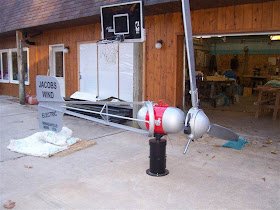There have been a number of attempts to try to harvest the waste heat that PV arrays produce for space or water heating -- here are a couple fairly recent additions.
PVT Solar's Echo System
This system is a combined PV and solar thermal system. Conventional PV panels are spaced a few inches above the roof plane leaving a space between the roof and the bottom of the PV panels. The top and sides of the PV array are closed off so that the only opening for airflow is along the bottom of the PV array. Fresh air is drawn in under the PV panels along the open bottom edge, and is heated as it progresses up between the hot PV panels and the roof. Vents through the roof at the top of the array take the heated air into the house and use the heated air to heat domestic water and/or for space heating.
 |
| Heat from the cavity formed under the sealed PV panels is collected and used for space and water heating. |
The PVT Solar concept is a very simple, and could certainly be implemented on a DIY basis. While the thermal performance is likely to be well under a good dedicated thermal collectors, the extra "free" thermal energy would likely be more than the electrical energy the PV array generates.
I would love to hear from anyone who has one of these systems, or know more about them.
More details and links on the PVTSolar system...
Solar Wall PV/T
This is a variation on SolarWall's well know transpired solar air heating collector system. In this version, PV panels are spaced over Solar Wall's transpired solar thermal collector absorbers. The SolarWall collectors draw in the heated air behind the PV panels.
 |
| The PV panels sit over the standard Solar Wall transpired air heating collectors |
It would be interesting to know how the thermal efficiency of this PV version of the Solar Wall compares to a regular Solar Wall. I would think the addition of the PV panels may reduce the thermal efficiency of the SolarWall because PV panels would not be as efficient an absorber as the SolarWall absorber they are shading?
I did not see any detailed performance numbers on their site.
More details and links on the Solar Wall PV/T product ...
It will be interesting to see whether these products do well.
Gary














































